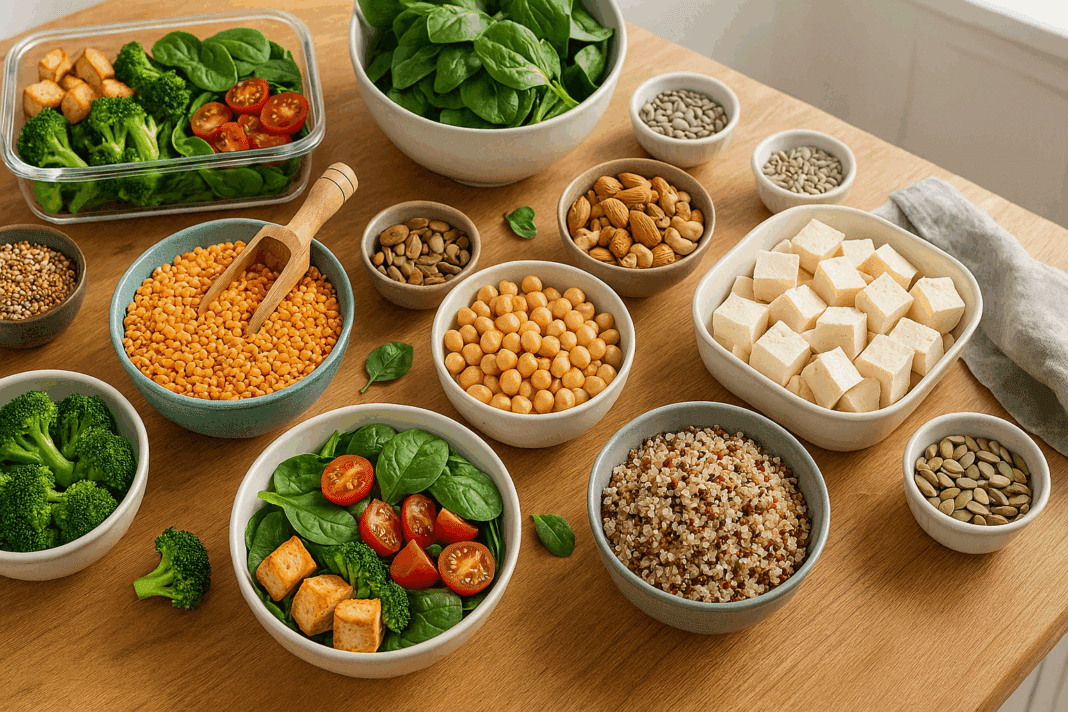The Rise of the High Protein Vegan Diet Plan: A New Era in Plant-Based Nutrition
In recent years, the conversation around protein has shifted dramatically. Once dominated by animal-based paradigms, the narrative is now expanding to include a wide variety of plant-derived options that are not only nutritionally complete but also environmentally and ethically aligned with modern values. This shift has given rise to a new generation of eaters—athletes, professionals, students, and everyday individuals—seeking a high protein vegan diet plan that supports muscle development, sustained energy, and overall health without compromising their plant-based ethics. As the popularity of this dietary approach continues to grow, so too does the scientific interest in its benefits, feasibility, and long-term impacts on health and performance.
Traditionally, the concept of “high protein” has been equated with steaks, eggs, and protein powders derived from whey or casein. However, growing awareness of the health risks associated with excessive consumption of red and processed meats—such as cardiovascular disease, inflammation, and certain cancers—has prompted many to explore alternative paths. Enter the high protein vegan meal plan, an evidence-based, nutrient-dense eating pattern that challenges outdated assumptions and redefines what it means to eat for strength and longevity.
At the heart of this transformation is a commitment to whole-food plant-based nutrition, a philosophy that prioritizes minimally processed, nutrient-rich ingredients derived entirely from plants. These foods not only provide ample protein but are also loaded with fiber, antioxidants, phytochemicals, and anti-inflammatory compounds that support cellular health and metabolic function. When properly designed, a high protein vegan diet meal plan can deliver all essential amino acids, optimize athletic performance, and foster long-term vitality.
You may also like: Smart Strategies for Plant-Based Eating on a Budget: How to Nourish Your Body Without Overspending

Dispelling the Protein Myth: Can Plants Really Build Muscle?
One of the most persistent myths in the world of fitness and nutrition is that plant-based diets fall short when it comes to meeting protein needs, particularly for those looking to build or maintain muscle mass. This misconception has been debunked repeatedly by research, yet it still lingers in popular discourse. The truth is that muscle protein synthesis—the biological process that repairs and builds muscle tissue—can be fully supported by plant proteins, provided that intake is adequate and diverse.
Proteins are composed of amino acids, nine of which are essential and must be obtained through the diet. While individual plant foods may lack one or more of these essential amino acids, consuming a variety of legumes, grains, nuts, seeds, and vegetables throughout the day ensures a complete amino acid profile. For example, pairing brown rice with black beans or lentils with quinoa creates a synergistic effect that mirrors the amino acid spectrum found in animal protein.
Moreover, plant-based protein sources such as tofu, tempeh, seitan, edamame, and legumes are not only high in protein but also provide other critical nutrients like iron, calcium, and magnesium. When strategically incorporated into a well-balanced meal plan, these foods make it entirely feasible to meet—and even exceed—recommended protein requirements, even for athletes and highly active individuals. A thoughtfully constructed high protein vegan diet plan can contain anywhere from 75 to 150 grams of protein per day, depending on caloric needs and activity level.
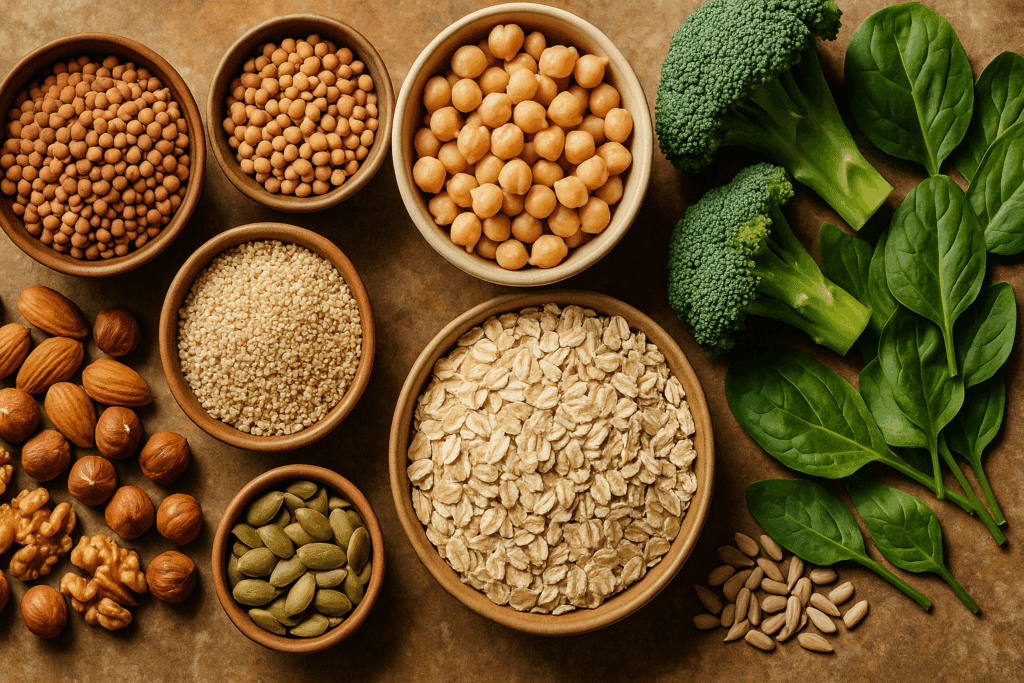
The Nutritional Foundation of a High Protein Vegan Meal Plan
A successful high protein vegan diet meal plan begins with an understanding of how to balance macronutrients—proteins, fats, and carbohydrates—while focusing on whole-food sources. While protein is often the focal point, it must be supported by adequate calories and other nutrients to ensure overall dietary sufficiency and optimal function.
Legumes are often the cornerstone of any high protein vegan diet. Lentils, chickpeas, black beans, and soy-based products like tofu and tempeh are not only protein-dense but also offer complex carbohydrates and a spectrum of micronutrients. Quinoa, a seed that behaves like a grain, is another standout. With around eight grams of protein per cup and a complete amino acid profile, quinoa serves as a versatile base for many meals.
Nuts and seeds, such as almonds, hemp seeds, chia seeds, and pumpkin seeds, also play a crucial role. These foods offer not only protein but also healthy fats, which are essential for hormone regulation, brain function, and nutrient absorption. Nut butters and seed pastes like tahini can be added to smoothies, dressings, and baked goods to boost protein content and improve satiety.
Vegetables, while not as protein-dense per calorie, contribute significantly to the overall protein intake when consumed in large volumes. Leafy greens like spinach, kale, and broccoli are surprisingly rich in amino acids, and their high fiber and antioxidant content make them indispensable in any plant-based diet.
Finally, whole grains such as oats, barley, farro, and buckwheat round out the nutritional profile. These grains provide not only carbohydrates for energy but also substantial amounts of protein and fiber, helping to stabilize blood sugar and support digestive health.

Building Strength and Endurance with Plant-Based Power
One of the most compelling arguments in favor of a high protein vegan meal plan is its potential to support physical performance. Contrary to outdated stereotypes, many elite athletes across disciplines—including bodybuilding, endurance racing, and strength training—have successfully adopted plant-based regimens to fuel their training and recovery.
Protein is critical for muscle repair and adaptation, particularly in response to resistance training and high-intensity workouts. But beyond just quantity, the quality of protein—and the context in which it’s consumed—matters greatly. Nutrient timing, or the strategic distribution of protein throughout the day, plays a key role in optimizing muscle synthesis. Experts recommend consuming protein-rich meals or snacks every three to four hours, especially within an hour post-exercise, to maximize recovery.
Smoothies have become a popular vehicle for post-workout nutrition, as they can easily incorporate plant-based protein powders (such as those made from pea, rice, or hemp), along with fruits, greens, flaxseed, and non-dairy milk. These nutrient-packed blends not only replenish glycogen stores but also deliver essential amino acids and antioxidants that mitigate oxidative stress and reduce inflammation.
It’s also worth noting that plant-based athletes often report faster recovery times and reduced joint pain, likely due to the anti-inflammatory properties of many plant foods. Unlike animal-based diets, which are often acid-forming and pro-inflammatory, a vegan diet rich in colorful vegetables, berries, legumes, and whole grains can help create a more alkaline internal environment, conducive to healing and performance.
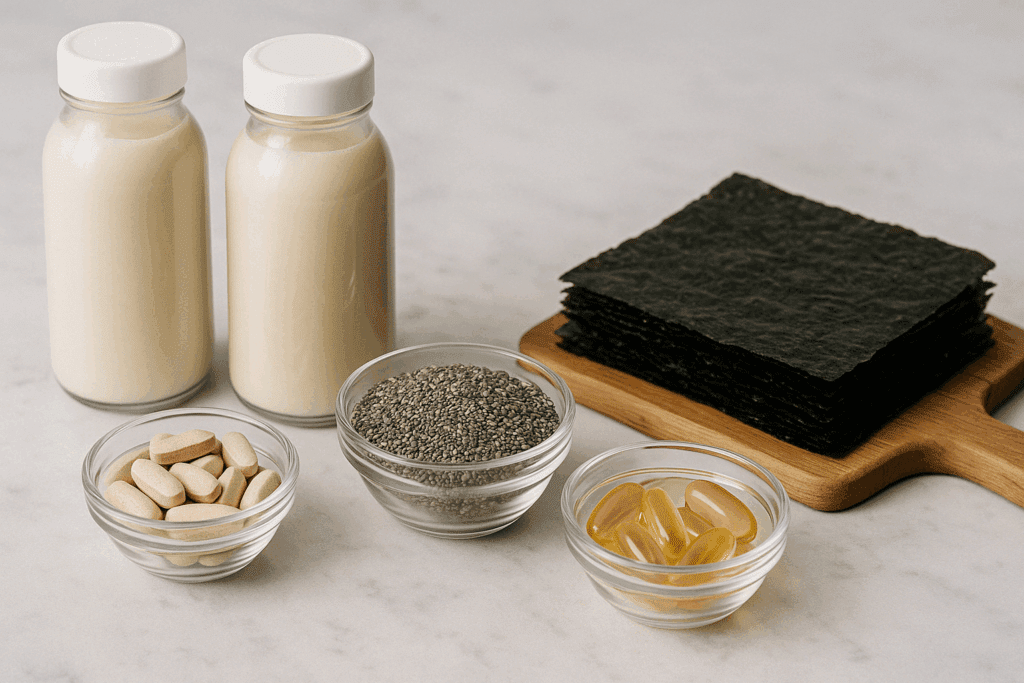
Preventing Nutrient Deficiencies: Smart Planning for Long-Term Success
While the benefits of a high protein vegan diet plan are substantial, careful planning is essential to avoid common nutritional pitfalls. Without proper attention to certain nutrients, individuals may experience deficiencies that could compromise energy levels, immune function, or overall health over time. This risk is not unique to veganism—every diet has its blind spots—but being proactive is key to thriving on a plant-based path.
Iron is one of the most commonly discussed nutrients in vegan circles. While plant-based iron (non-heme) is less readily absorbed than heme iron from animal products, consuming iron-rich foods alongside vitamin C–rich ingredients significantly enhances absorption. For example, pairing lentils with tomato sauce or spinach with citrus vinaigrette can boost iron bioavailability.
Vitamin B12 is another critical nutrient that must be supplemented or obtained from fortified foods, as it is not naturally found in plant sources. B12 plays an essential role in nerve function and red blood cell production, and its deficiency can lead to fatigue, cognitive issues, and anemia. Most health professionals recommend a reliable B12 supplement as part of any long-term vegan plan.
Calcium, zinc, iodine, and omega-3 fatty acids are also nutrients that require mindful inclusion. Fortified plant milks, sea vegetables like nori, flaxseeds, chia seeds, and walnuts can help meet these needs. In some cases, supplementation may be advisable, particularly for individuals with increased demands or absorption challenges.
Ultimately, a well-designed high protein vegan diet meal plan should be diverse, colorful, and inclusive of a wide range of whole foods. By combining culinary creativity with evidence-based planning, individuals can enjoy all the benefits of a high-protein lifestyle while adhering to plant-based principles that support personal health, environmental sustainability, and ethical integrity.
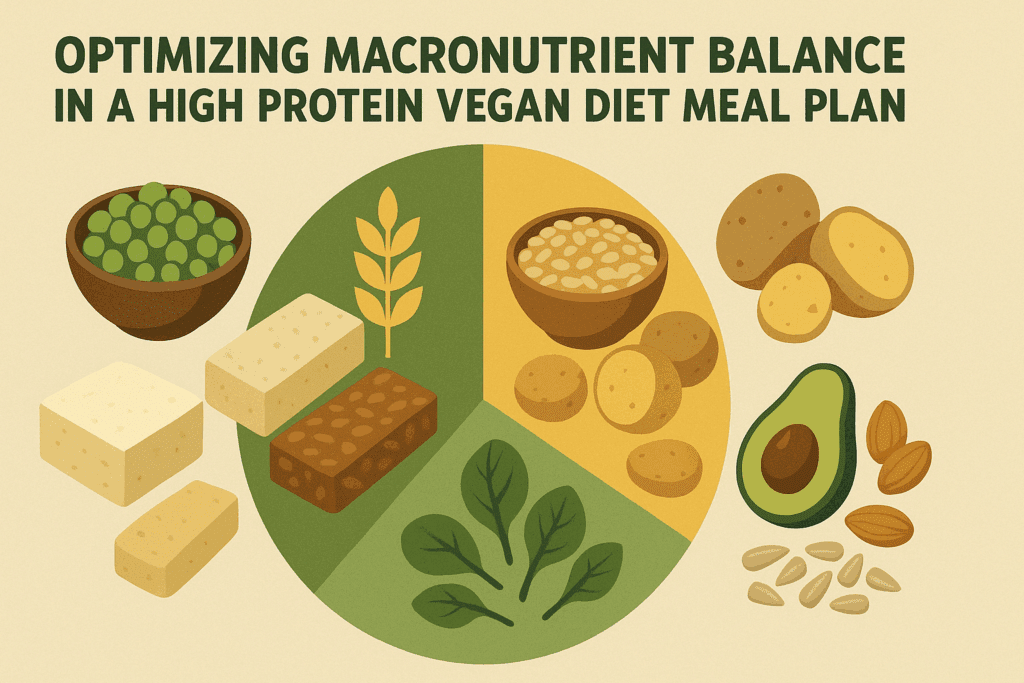
Optimizing Macronutrient Balance in a High Protein Vegan Diet Meal Plan
Achieving optimal health and performance on a high protein vegan diet meal plan requires more than simply reaching daily protein targets. A balanced intake of macronutrients—proteins, carbohydrates, and fats—is essential for supporting muscle synthesis, metabolic efficiency, hormonal balance, and long-term well-being. While protein provides the raw materials for tissue repair and maintenance, carbohydrates remain the body’s primary source of fuel, particularly for those engaging in high-intensity training or physically demanding routines. Simultaneously, healthy fats play a critical role in cellular function, brain health, and nutrient absorption.
In the context of a plant-based lifestyle, carbohydrates are plentiful and often misunderstood. Complex carbohydrates from whole grains, legumes, vegetables, and fruits are slowly digested, helping to maintain stable blood glucose levels while providing steady energy throughout the day. Far from being detrimental, these carbohydrates are essential to maximizing performance and ensuring that protein is used for repair rather than energy. Those following a high protein vegan diet plan should aim to pair their protein sources with whole, fiber-rich carbs to support muscle glycogen replenishment and overall metabolic health.
Fats, particularly those from plant sources, are equally important. Avocados, nuts, seeds, and oils such as flaxseed and olive oil provide omega-3 and omega-6 fatty acids that reduce inflammation, support cardiovascular health, and enhance brain function. Contrary to outdated dietary dogma, moderate consumption of healthy fats can aid in satiety and contribute to a well-rounded meal plan that sustains both physical and mental energy. Including a variety of fat sources also ensures that fat-soluble vitamins—A, D, E, and K—are properly absorbed and utilized by the body.
The art of balancing these macronutrients lies in personalization. While general guidelines exist, factors such as age, body composition, activity level, and personal goals will influence individual needs. Some individuals may thrive on a 40/30/30 split of carbohydrates, proteins, and fats, while others may require adjustments to better support endurance or strength training regimens. Flexibility, variety, and nutrient density are the cornerstones of a sustainable high protein vegan meal plan that adapts to changing physiological demands.
The Role of Meal Timing and Frequency in Maximizing Protein Absorption
For individuals committed to building muscle, improving recovery, or stabilizing energy levels throughout the day, the timing and distribution of protein intake play an influential role. While total daily protein intake remains the most critical factor, how and when that protein is consumed can enhance its effectiveness. Studies in sports nutrition have consistently shown that consuming protein-rich meals at regular intervals—typically every three to four hours—can stimulate muscle protein synthesis more efficiently than consuming the same amount of protein in fewer, larger servings.
On a high protein vegan meal plan, this translates to incorporating high-quality protein sources into breakfast, lunch, dinner, and one or two snacks. Instead of concentrating protein intake in a single evening meal, spreading it out across the day allows for continual stimulation of anabolic processes, which are crucial for tissue growth and repair. For example, starting the day with a smoothie that includes plant-based protein powder, hemp seeds, and nut butter sets a strong nutritional foundation. A midday quinoa and lentil bowl, a tofu stir-fry for dinner, and a handful of roasted chickpeas as a snack help maintain consistent amino acid availability.
Post-workout nutrition is another critical element for those aiming to build strength or enhance endurance. The period immediately following exercise—often referred to as the “anabolic window”—is an opportune time to consume protein and carbohydrates to accelerate recovery and muscle repair. While the length and importance of this window are debated, most sports dietitians agree that consuming a protein-rich snack or meal within one hour of exercise is beneficial. For plant-based athletes, a post-workout shake with a complete protein blend, along with a banana or oats, can effectively jumpstart the recovery process.
Incorporating variety into these meals is also essential. Repetitive consumption of the same protein sources may lead to nutrient imbalances or palate fatigue. Rotating between legumes, tofu, tempeh, grains, seeds, and fortified products helps ensure a broader intake of vitamins, minerals, and amino acids while keeping meals enjoyable and satisfying. The key is to make protein a consistent, intentional component of every eating occasion, seamlessly integrated into meals that are both delicious and functional.
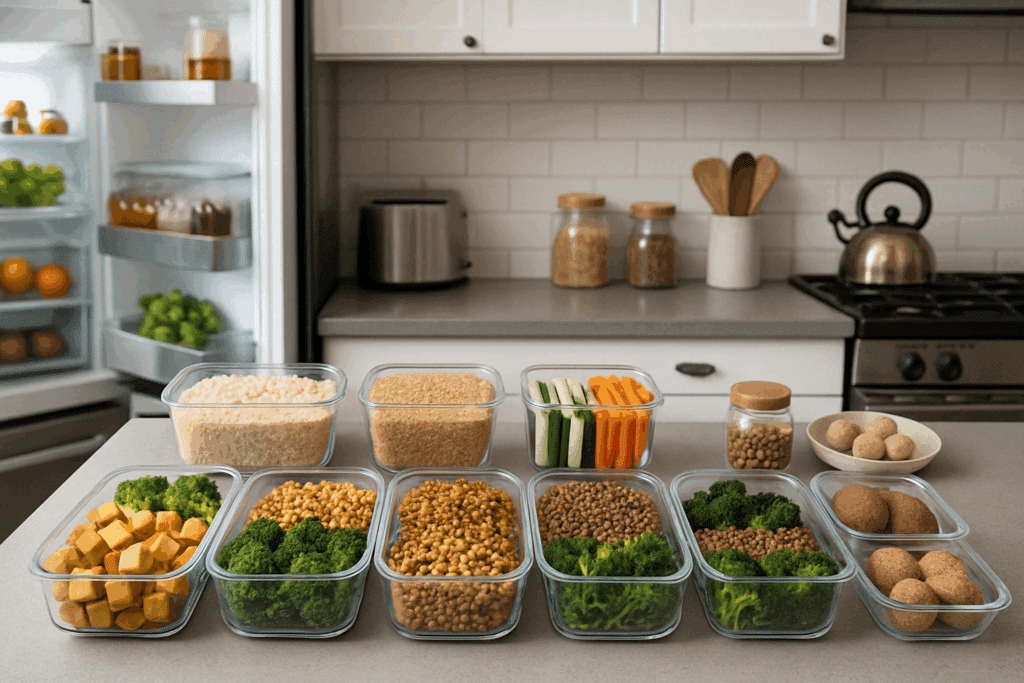
Sustainable Meal Planning Strategies for Busy Lifestyles
Creating and maintaining a high protein vegan diet plan may seem daunting at first, particularly for individuals juggling busy schedules, work commitments, or family responsibilities. However, with a strategic approach to meal planning and preparation, it becomes not only manageable but also enjoyable. The foundation of effective meal planning lies in consistency, organization, and smart grocery shopping that prioritizes whole, plant-based staples.
Batch cooking is one of the most efficient ways to ensure that high-protein meals are readily available throughout the week. Preparing large quantities of lentils, quinoa, baked tofu, and roasted vegetables in advance can save valuable time and prevent reliance on less nutritious convenience foods. Pre-washed greens, frozen edamame, and canned beans are also time-saving staples that can be quickly incorporated into salads, wraps, or grain bowls.
Storing meals in portioned containers and labeling them by day or meal type reduces decision fatigue and supports adherence to nutritional goals. For individuals tracking macronutrient intake or working toward specific fitness outcomes, this method provides consistency and control over portion sizes and nutrient balance. Apps and digital tools can further streamline this process, offering recipe suggestions, shopping lists, and nutrition tracking based on individual targets.
For those with limited cooking skills or access to fresh ingredients, frozen and shelf-stable plant-based products can be valuable allies. High-protein frozen meals, veggie burgers, and shelf-stable plant milks offer convenience without compromising nutrition. While whole foods should remain the foundation of any high protein vegan meal plan, selectively incorporating minimally processed items can add variety and ensure that protein needs are consistently met.
Meal planning also offers psychological benefits, reducing stress and promoting mindfulness around eating. Knowing in advance what will be eaten eliminates the guesswork that often leads to skipped meals or impulsive choices. This level of intentionality aligns with the principles of a health-focused, plant-based lifestyle, reinforcing positive habits and fostering a greater connection to the food being consumed.

Supporting Hormonal and Metabolic Health with Plant-Based Protein
While the primary focus of a high protein vegan diet plan often centers on muscle building and energy, its impact on hormonal and metabolic health is equally significant. Protein plays a vital role in the synthesis of hormones, enzymes, and neurotransmitters that govern everything from appetite regulation to sleep quality. By prioritizing plant-based protein sources rich in essential amino acids, individuals can support endocrine function while also benefiting from the anti-inflammatory properties of plants.
Fiber, which is abundant in legumes, whole grains, and vegetables, works synergistically with protein to regulate blood sugar levels and support insulin sensitivity. This can be particularly beneficial for individuals with prediabetes, polycystic ovary syndrome (PCOS), or metabolic syndrome, conditions that are often influenced by dietary habits. Unlike many animal-based high-protein diets, a vegan approach does not carry the same risks of saturated fat intake and has been associated with improved metabolic markers in numerous studies.
Furthermore, phytoestrogens found in soy products such as tofu and tempeh may offer additional hormonal benefits, particularly for women. These naturally occurring plant compounds can mimic estrogen in the body, potentially alleviating symptoms of menopause and supporting bone health. While controversial in the past, current research suggests that moderate soy consumption is safe and may even be protective against hormone-related cancers.
Another advantage of plant-based protein is its role in appetite regulation and satiety. High-protein meals, especially those with a high fiber content, promote fullness and reduce cravings, making it easier to maintain a healthy weight. This dual benefit of protein and fiber is unique to plant-based sources and contributes to a more sustainable approach to weight management compared to low-carb or restrictive diets.
Incorporating a variety of plant proteins not only supports physiological needs but also diversifies the microbiome, which plays an increasingly recognized role in hormone regulation, immunity, and even mood. Fermented foods such as miso, tempeh, and sauerkraut can further enhance gut health by introducing beneficial bacteria that promote balance and resilience in the digestive system.
The Environmental and Ethical Case for a High Protein Vegan Meal Plan
Beyond personal health and physical performance, one of the most powerful motivations for adopting a high protein vegan meal plan lies in its broader impact on the planet and animal welfare. Livestock farming is a significant contributor to greenhouse gas emissions, deforestation, and water pollution. In contrast, plant-based diets require fewer resources and generate less environmental harm, making them a more sustainable choice in the face of global climate challenges.
By shifting dietary habits toward legumes, grains, seeds, and other plant protein sources, individuals can significantly reduce their carbon footprint. For example, producing one kilogram of lentils generates far fewer emissions than producing the same amount of beef or pork. Additionally, crops grown for direct human consumption are generally more efficient and ethical than those used for animal feed, allowing for better use of arable land and water.
The ethical benefits are also clear. A high protein vegan diet plan avoids the moral complexities associated with industrial animal agriculture, including issues related to animal welfare, antibiotic overuse, and exploitative labor practices. Choosing plant-based proteins aligns dietary choices with values of compassion, sustainability, and social responsibility—principles that resonate with a growing number of consumers seeking to live with greater integrity.
For many, the decision to adopt a high protein vegan diet meal plan begins with personal goals—such as muscle building or improving energy—but evolves into a broader lifestyle grounded in ethical awareness and environmental stewardship. This evolution reflects the multifaceted nature of food choices, which extend far beyond the plate and into every aspect of life.
Frequently Asked Questions: High Protein Vegan Diet Plan
1. What are some overlooked but effective plant-based sources of protein?
While lentils, tofu, and chickpeas are widely recognized, many high-protein vegan diet plan enthusiasts overlook lesser-known sources such as lupini beans, amaranth, and nutritional yeast. Lupini beans contain up to 25 grams of protein per cup and are particularly rich in prebiotics. Amaranth, a pseudograin similar to quinoa, provides a complete protein profile with added benefits for heart health. Nutritional yeast not only enhances flavor but also delivers up to eight grams of protein per two tablespoons, along with B-complex vitamins. These underutilized ingredients can diversify a high protein vegan meal plan while boosting micronutrient intake.
2. Can a high protein vegan meal plan support weight loss while preserving lean muscle mass?
Yes, when designed thoughtfully, a high protein vegan meal plan can aid fat loss while maintaining or even increasing muscle. The key lies in creating a slight caloric deficit paired with adequate protein intake and resistance training. Because plant-based proteins are often accompanied by fiber, they enhance satiety and stabilize blood sugar, which can help reduce cravings. By timing protein-rich meals throughout the day and incorporating strength-focused exercise, individuals can preserve lean body mass while reducing fat stores. This approach ensures that a high protein vegan diet meal plan promotes sustainable body recomposition rather than short-term weight loss.
3. How can I avoid digestive issues when increasing fiber and plant protein intake?
Transitioning to a high protein vegan diet plan can sometimes lead to bloating or gas due to increased fiber, especially from legumes and whole grains. To ease the adjustment, it’s advisable to increase fiber intake gradually and ensure adequate hydration. Soaking and cooking beans thoroughly or choosing sprouted versions can improve digestibility. Incorporating fermented foods like tempeh, sauerkraut, or plant-based yogurt may also support gut health during the transition. Over time, the gut microbiome adapts, and many people find improved digestion as a long-term benefit of the high protein vegan meal plan.
4. Are there differences in amino acid absorption between plant and animal protein?
Yes, plant proteins often have slightly lower digestibility scores due to anti-nutrients like phytates and fiber. However, this does not mean they are ineffective. Combining a variety of protein sources throughout the day ensures all essential amino acids are consumed and absorbed efficiently. Cooking, fermenting, and sprouting also improve amino acid availability. Many high protein vegan diet meal plans now include complementary combinations, such as rice with beans or oats with chia seeds, which help match or exceed the anabolic potential of animal proteins. The overall quality of a high protein vegan diet plan depends more on diversity and preparation than on individual ingredients.
5. What are the long-term cardiovascular benefits of a high protein vegan diet meal plan?
A high protein vegan meal plan supports cardiovascular health through multiple mechanisms, including lower saturated fat intake and higher fiber, potassium, and antioxidant consumption. Over time, this can lead to reductions in LDL cholesterol, improved blood pressure, and enhanced endothelial function. Some studies have even shown regression of atherosclerosis in individuals who adopt whole-food, plant-based diets. The protective effects are magnified when combined with regular physical activity and stress management. Thus, a high protein vegan diet plan may not only prevent heart disease but potentially reverse early markers of vascular dysfunction.
6. How does a high protein vegan diet meal plan affect cognitive function and mental clarity?
Emerging research suggests that diets rich in plant-based proteins and polyphenols may support brain health and reduce cognitive decline. A high protein vegan diet plan naturally includes foods like legumes, seeds, and leafy greens that are high in magnesium, iron, and B-vitamins—nutrients essential for neurotransmitter function and brain energy metabolism. Additionally, plant-based diets tend to lower systemic inflammation, which has been linked to improved mood and mental clarity. While more long-term studies are needed, many individuals report enhanced focus, mood stability, and reduced brain fog after adopting a consistent high protein vegan meal plan.
7. What role does resistance training play in optimizing a high protein vegan diet plan?
Resistance training is a powerful catalyst for muscle synthesis, and its synergy with a high protein vegan diet plan can yield exceptional results. Lifting weights or engaging in bodyweight resistance exercises stimulates muscle protein synthesis, making the body more responsive to dietary protein. This is particularly important in vegan nutrition, where strategic timing and nutrient density are crucial. Post-workout meals combining carbs and protein—like a quinoa and tempeh bowl—can further enhance anabolic signaling. For those on a high protein vegan meal plan aiming to gain muscle, aligning training and nutrition is critical to maximizing results.
8. Are high protein vegan meal plans suitable for older adults concerned with sarcopenia?
Absolutely. Older adults often experience age-related muscle loss, known as sarcopenia, and a high protein vegan diet plan can effectively counteract this condition. While protein needs may be higher for older populations, plant-based diets can be tailored to meet these demands using nutrient-dense, easy-to-digest options. Smoothies with protein powders, stews rich in legumes, and fortified plant milks make protein more accessible for those with decreased appetite or chewing difficulties. When paired with light strength training or functional movement, a high protein vegan meal plan can promote independence, balance, and healthy aging.
9. How can travelers or busy professionals maintain a high protein vegan diet on the go?
Maintaining a high protein vegan diet meal plan while traveling or working long hours requires foresight and adaptability. Packing portable options like roasted chickpeas, protein bars, trail mixes, or shelf-stable tofu ensures access to quality nutrients. Many airports, hotels, and restaurants now offer vegan-friendly meals—look for grain bowls, wraps with hummus or lentils, or smoothies with nut butters. Meal delivery services and apps can also help locate high protein vegan meal options when time is limited. Flexibility and preparation are key to staying consistent, especially in unpredictable environments.
10. What innovations are shaping the future of high protein vegan diet meal plans?
The future of the high protein vegan diet plan is being shaped by exciting innovations in food technology and personalized nutrition. Companies are developing fermented and cultivated plant proteins that more closely mimic the amino acid profiles of meat. AI-powered apps can now generate custom high protein vegan meal plans based on genetics, activity level, and health metrics. Additionally, sustainable protein sources like algae, fava beans, and lupin are gaining traction due to their high yield and low environmental impact. As research continues, expect to see increasingly sophisticated options that make adopting a high protein vegan diet meal plan more accessible, personalized, and performance-optimized than ever before.
Conclusion: Embracing the Power of a High Protein Vegan Diet Plan for Total Wellness
The path to vibrant health, muscular strength, and lasting energy does not require animal products—it can be fully realized through a thoughtfully crafted, whole-food plant-based lifestyle. A high protein vegan diet plan, when executed with intention and knowledge, delivers more than just protein. It provides a nutrient-rich foundation that supports physical performance, hormonal balance, cognitive clarity, and immune resilience. With careful planning and a diverse range of protein-rich plants, it is entirely possible to meet and exceed nutritional needs while embracing ethical and environmental values.
From improved metabolic health to faster recovery times and reduced inflammation, the benefits of a high protein vegan meal plan are supported by both science and lived experience. It is not simply a diet but a holistic approach to wellness—one that honors the interconnectedness of health, sustainability, and compassion. For anyone seeking a path that nourishes the body, protects the planet, and aligns with conscious living, the high protein vegan diet meal plan stands as a powerful, transformative choice.
Was this article helpful? Don’t let it stop with you. Share it right now with someone who needs to see it—whether it’s a friend, a colleague, or your whole network. And if staying ahead on this topic matters to you, subscribe to this publication for the most up-to-date information. You’ll get the latest insights delivered straight to you—no searching, no missing out.
Further Reading:
7-Day High-Protein Vegan Diet Meal Plan, Created by a Dietitian

